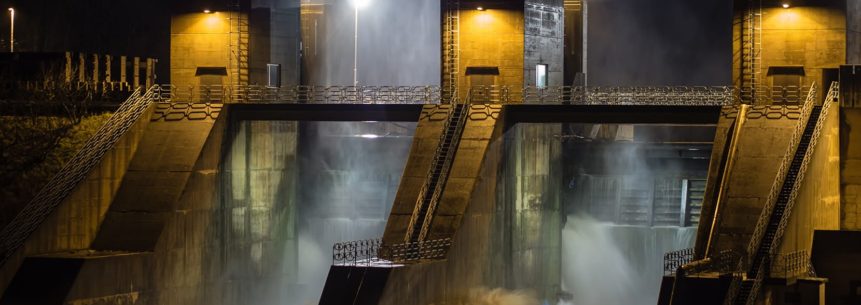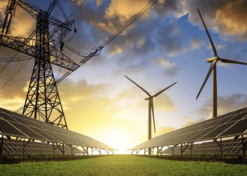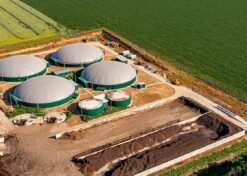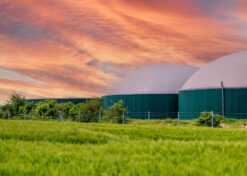
Alternatives to the Pioneer-Burdekin pumped storage hydro development in Queensland
Alternatives to the Pioneer-Burdekin pumped storage hydro development in Queensland | 10th October 2022Quick Summary
The use of renewable methane gases in gas power station technology looks to be an attractive alternative to large scale pumped hydro facilities, and the amount of gas required is relatively small. This would avoid the need for large dam developments and make use of agricultural capabilities, repurposing of gas infrastructure and provide long-term, skilled jobs for the power industry and regional workers.
Queensland Energy and Jobs Plan – Large pumped hydro proposal for Pioneer-Burdekin.
In the Queensland “Energy and Jobs Plan” released in late September 2022 the Queensland Government set a target for renewable energy 70 per cent by 2032 and 80 per cent by 2035, which is to be highly commended.
In order to reliably meet the forecast demand of some 10 to 13 GW over the period to 2040 this would require:
- 25 GW of new and existing renewable (super) grid energy (variable electricity generation – largely wind and solar), and 11 GW of rooftop solar and 6 GW of batteries in homes and businesses.
- 8 times the current renewable energy generation.
- To assist to firm this variable electricity generation some 7 GW of “long duration” storage (where long duration is characterised as 24 hours of continuous output)
- So, 7 x 24 = 168 GWh
- Which for comparisons purpose is some 2.5 times the capacity (GW) and ½ the actual energy storage (GWh) of Snowy 2.0, and
- Up to 3 GW of low to zero emission gas (hydrogen) generation for periods of peak demand and backup security.
- And some 1,500 km of new power transitions systems to be constructed.
All in all, entailing an estimated investment of some $62 billion.
Pumped Hydro development issues
As part of this development the main pumped storage hydro proposed to be built is the Pioneer Burdekin Hydro system – at 5 GW capacity and enough storage to run for 24 hours (120 GWh), and is touted as the largest pumped hydro system in the world.
However, this is also likely (inevitably) to be the most controversial of the developments being considered as it will require major dam development up stream and downstream of the hydro generation units and procurement in some way of the required water and maintenance of that water resource.
This is not a trivial undertaking as it will affect many people and local ecologies. The history of such developments has shown they can and do give rise to major ecological approvals resistance and deep community concern (particularly by those affected). They also tend to escalate in costs as the approvals processes drag on, with attendant project delays (Snowy 2.0 being a prime example).
There are also many social licence bridges to be crossed with any such large scale and disruptive project.
The Government has allocated $273.5m of funding to advance the pumped hydro scheme developments and is establishing a publicly owned entity “Queensland Hydro”, and this amount and dedicated focus indicates the level of pre-construction work and community engagement being anticipated.
Expanded use of renewable gases
In our view, an alternative that looks extremely promising and should therefore also be considered and analysed is to use more renewable gas based generation, specifically the production and use of renewable methane gases (biomethane in particular and renewable methane).
Renewable methane gases are classified as net zero emission gases (like hydrogen) and totally interchangeable with natural gas in all the gas infrastructure (unlike hydrogen, although hydrogen can be used to make renewable methane gases). The gas infrastructure in Queensland is already a substantial investment that will need repurposing as the State transitions to net zero emissions and eradicates natural gas.
These renewable methane gases also offer an alternative for hard to abate industry usage (of natural gas) and for the eventual replacement of LNG exports, a $50 billion/year earner.
The Plan does call for the development of 3 GW of gas power generation using “low to zero emission gas”, which in the Plan is defined as hydrogen. It does not appear though to contemplate the use of biomethane or renewable methane in the existing gas systems as a major source of backup for variable renewable generation. And yet the existing gas system in Queensland already has a vastly greater storage capability for renewable energy than the proposed Pioneer Burdekin Pumped Hydro system.
In fact, the Pioneer Burdekin Pumped Hydro storage of 120 GWh could be replaced with 1 to 2 PJ of biomethane or renewable methane (used as fuel in 5 GW of peaking gas power stations). This in gas industry terms is a very small amount of gas. For example, the east coast domestic gas market demand consumes some 570 to 600 PJ/year, and Queensland produces some 1,600 PJ/year.
- The National Bioenergy Roadmap also identified that Queensland had some 30% of Australia’s total bioenergy resource (some 786 PJ in total, and likely some 390 PJ useable).
- The Roadmap estimated that the potential in Queensland from urban waste alone was some 200 PJ/year.
- Existing landfill and waste water facilities could produce up to 18 PJ/year – enough to easily meet this 1 to 2 PJ/year target already, and
- Electricity currently produced from waste biomass in Queensland is some 1,200 GWh/year.
There are many, many benefits to be gained from using renewable methane gases
There are many potential benefits to consider:
- Queensland will not have to build the dams (up and downstream) and will avoid all the ecological impacts and community dislocation issues, but still have clean energy jobs.
- Queensland is highly capable of building the 5 GW of (biomethane fuelled) gas power generation plants instead as these are existing, off-the-shelf technology – they would not have to be “hydrogen ready” or wait to be able to have hydrogen ready development (but still could be).
- The existing power companies are very familiar with this technology and in any case the Plan already calls for 3 GW of this technology.
- These could be built at the existing power station sites and presumably run by existing staff, with gas piped or delivered to these stations (e.g., as CNG).
- So, jobs would be maintained in the same regions as they now exist.
- It will also avoid relying on one major location and very large plant – diversity of supply provides greater system security.
- These gas fired power generators can also be phased in as coal is phased out.
- The delivery time frame will not be as critical, and
- The costs are far more controllable.
- They can use local skills that need to transition to the clean energy economy.
- They can be backed up by natural gas until the renewable gases are developed.
- This will lower the states emissions very quickly in the sector as the emissions are largely driven by coal fired power generation, with
- Resultant emission reductions of the order of 70%.
- This gas power generation transition pathway has been well proven (for example in South Australia[1]).
- It also allows for the more rapid development of renewable generation plants as there is very little concern about backup during the transition with their variability as they come on-line (again as is the proven case in SA).
- These assets will be more usable as significantly more renewable methane can be produced and stored in the existing gas systems than is needed to replace just the pumped hydro facility.
- For example – to run the 5 GW of renewable gas fired power generation for 30 days would require some 30 PJ of renewable methane gas and AGLs Queensland Silver Springs underground gas storage asset is 35 PJ alone (13 x Snowy 2.0) – the storage already exists in the current gas infrastructure, and
- This means having access to much larger renewable energy storage, as 24 hours is not sufficient based on existing data from the NEM – there are much longer lulls in wind and solar generation in the existing data – which is not surprising given the wind and solar are weather driven.
- This provides very deep security to the Queensland electricity supply system should for example there also be a major weather event.
- Provides a simple renewable gas alternative for current gas users – they will have no costs to convert to other forms of renewable energy (or risk having to shut down).
- This would give a distinct State advantage as well for attracting such industries, and
- It will provide longer term clean energy options for households and businesses.
- Building up the biomethane industry could make Queensland a major powerhouse for this kind of development.
- Biomethane is a regional development activity as it will require access to biomass, and
- Queensland is already one of the largest biomass producers in Australia.
- The farmers in the Pioneer-Burdekin region may well be prime suppliers e.g., via long term contracts for biomass – energy farmers.
- It will also allow solutions around waste biomass and the treatment of waste water, as we are seeing for example expanding in Victoria through Government support.
- There is an estimated 18 PJ/year available from existing landfill and waste water sources in Queensland for example, and
- Biorefineries that may consume 1/2 million tonnes/year of biomass – to produce enough gas to replace the pumped hydro energy.
- Renewable methane produced from hydrogen has no biological limits and is highly scalable, but again is likely to be a regional or industrial hub activity.
- The development of a new renewable methane industry using the biogenic carbon dioxide from the biomethane industry combined with hydrogen, or
- From direct air capture carbon dioxide (DAC), and associated
- Carbon Capture Use and Storage (CCUS).
- Methanation technology is available worldwide and used extensively in refineries, and
- This methanation technology is the subject of great interest in terms of the potential for major technology developments – for example the GETCO2 CRC proposal which includes 8 Universities (led by UQ), CSIRO, several international Universities, and OGW, and
- By the major gas producers who will be able to repurpose their gas underground reservoirs (already linked to gas pipelines) – Santos already has major DAC and CCUS plans for example.
- Will actually produce energy and sequester carbon – renewable methane production can be a lot more than just a battery system in Queensland.
- Pumped hydro does not produce energy for example – it consumes energy in its pumping and storage cycle.
- The carbon benefit of pumped hydro is in the energy stored only (that is not emitted from fossil fuels), not sequestered from the atmosphere as in the case of biomethane or renewable methane for example.
- Major capital costs may be avoided, as much as 50% of those forecast for such large scale pumped hydro developments.
- Gas power generation plant is a very mature technology. In the AEMO Assumptions Workbook for 2022 large Open Cycle Gas Turbines (large OCGT) in Queensland has a quoted “Build and Connection Cost” of $868,300/MW – for the 5 GW = $4.34 billion.
- The biorefinery and associated infrastructure build would be likely less than $1 billion, and have ongoing costs associated with feedstock and operations.
- Pumped hydro has larger capital costs (in this case quoted as $12 billion for the Pioneer Burdekin 5 GW development) and major ongoing operating costs in the pumping requirements.
Renewable methane gases are worthy of study as an alternative or at least a major adjunct to scaled back pumped hydro developments
The answer here is to do the studies of this attractive, alternative opportunity as the impacts are likely to be very positive for the State, for customers, for the environment, for the development of new industries and for the Pioneer Burdekin region community if it is proven.
They will also provide quality, long-term jobs in Queensland while minimising the ecological damage of major dams and provide a future for those in the coal production and power generation industries. Renewable gas power stations and bio-refineries will need exceptional skills to develop, run, expand and maintain as will renewable methane refineries based on hydrogen production.
They will directly remove carbon from the atmosphere and provide many options for peaking, backup and even base load power production, as well as direct zero emission gas supplies to industry and even households.
They will also strongly support the rest of the current Energy and Jobs Plan developed by the Government.
The new technology developments that can follow on are also very exciting and being led by local researchers – we could end the cycle of buying the technology from off-shore.
[1] OGW has recently also published papers looking at “extended (VRE) droughts” – extended periods where solar and wind are not available (out across a whole month for example – the famous German term of “dunkelflaute”), and that analysis has focused on SA as a case study. This has shown the impacts and usefulness of gas as a transition fuel (using many years of actual data) for renewables development and final back up for these extended periods of low solar and wind availability using renewable methane gases.
Download the report here. For more information please contact Executive Directors Jim Snow or Angus Rich.



